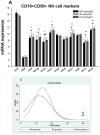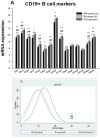Immune Cell Repertoire and Their Mediators in Patients with Acute Myocardial Infarction or Stable Angina Pectoris
- PMID: 28260995
- PMCID: PMC5332848
- DOI: 10.7150/ijms.17119
Immune Cell Repertoire and Their Mediators in Patients with Acute Myocardial Infarction or Stable Angina Pectoris
Abstract
Background: To evaluate the natural innate and adaptive immunity through gene expression and cytology levels in peripheral blood mononuclear cells in patients with acute myocardial infarction (AMI), stable angina pectoris (SAP) and controls. Methods: 210 patients with AMI, 210 with SAP, and 250 clinical controls were recruited. Whole human genome microarray analysis was performed in 20 randomly chosen subjects per group were examined to detect the expressions of complement markers, natural killer cells, T cells and B cells. The quantity of these cells and related cytokines as well as immunoglobulin levels were measured in all subjects. Results: In AMI group, the mRNA expressions of late complement component, markers of natural killer cells, CD3+, CD8+ T cells and B cells were down-regulated, while those of early complement component and CD4+T cells were up-regulated (p<0.05). In both AMI and SAP patients, the quantity of natural killer cells, CD3+, CD8+ T cells, B cells, IgM and IgG were significantly lower than those of the controls. CD4+ T cells, CH50, C3, C4, IL-2, IL-4, IL-6 and IFN-γ were significantly higher (p<0.05). Conclusions: In AMI patients, both of gene expressions related to complement, natural killer cells, CD3+, CD8+ T cells, B cells and the quantity of these immune cells decreased while cell number reduced in SAP patients. Immune function in both AMI and SAP patients decreased especially in AMI patients with declined gene and protein levels. To improve the immune system is a potential target for medical interventions and prevention in AMI.
Keywords: adaptive immunity.; gene expression; innate immunity; myocardial infarction; stable angina pectoris.
Conflict of interest statement
Competing Interests: The authors have declared that no competing interest exists.
Figures




Similar articles
-
Depletion of complement system immunity in patients with myocardial infarction.Mol Med Rep. 2016 Dec;14(6):5350-5356. doi: 10.3892/mmr.2016.5912. Epub 2016 Nov 1. Mol Med Rep. 2016. PMID: 27840920
-
Differential loss of natural killer cell activity in patients with acute myocardial infarction and stable angina pectoris.Int J Clin Exp Pathol. 2015 Nov 1;8(11):14667-75. eCollection 2015. Int J Clin Exp Pathol. 2015. PMID: 26823790 Free PMC article.
-
[Two-color flow cytometry analysis of lymphocyte subsets in patients with acute myocardial infarction and post-myocardial infarction syndrome].J Cardiol. 1995 Aug;26(2):69-79. J Cardiol. 1995. PMID: 7674146 Japanese.
-
CD100 modulates cytotoxicity of CD8+ T cells in patients with acute myocardial infarction.BMC Immunol. 2021 Feb 16;22(1):13. doi: 10.1186/s12865-021-00406-y. BMC Immunol. 2021. PMID: 33593275 Free PMC article.
-
Regulatory T cells as a therapeutic target in acute myocardial infarction.Mol Immunol. 2024 Aug;172:17-22. doi: 10.1016/j.molimm.2024.06.003. Epub 2024 Jun 11. Mol Immunol. 2024. PMID: 38865800 Review.
Cited by
-
Role of Inflammatory Cell Subtypes in Heart Failure.J Immunol Res. 2019 Sep 2;2019:2164017. doi: 10.1155/2019/2164017. eCollection 2019. J Immunol Res. 2019. PMID: 31565659 Free PMC article. Review.
-
Effect of various doses of rosuvastatin in the treatment of elderly patients with unstable angina pectoris.Am J Transl Res. 2022 Jan 15;14(1):594-602. eCollection 2022. Am J Transl Res. 2022. PMID: 35173877 Free PMC article.
-
Identification of Immune-Related Genes in Patients with Acute Myocardial Infarction Using Machine Learning Methods.J Inflamm Res. 2022 Jun 3;15:3305-3321. doi: 10.2147/JIR.S360498. eCollection 2022. J Inflamm Res. 2022. PMID: 35692951 Free PMC article.
-
Impact of bleeding during dual antiplatelet therapy in patients with coronary artery disease.Sci Rep. 2020 Dec 7;10(1):21345. doi: 10.1038/s41598-020-78400-4. Sci Rep. 2020. PMID: 33288822 Free PMC article.
-
Identification of very early inflammatory markers in a porcine myocardial infarction model.BMC Vet Res. 2019 Mar 12;15(1):91. doi: 10.1186/s12917-019-1837-5. BMC Vet Res. 2019. PMID: 30898123 Free PMC article.
References
-
- Libby P, Ridker PM, Hansson GK. Progress and challenges in translating the biology of atherosclerosis. Nature. 2011;473:317–325. - PubMed
-
- Libby P, Theroux P. Pathophysiology of coronary artery disease. Circulation. 2005;111:3481–3488. - PubMed
-
- Shah PK. Pathophysiology of coronary thrombosis: role of plaque rupture and plaque erosion. Prog Cardiovasc Dis. 2002;44:357–368. - PubMed
-
- Levi M, van der Poll T, Schultz M. New insights into pathways that determine the link between infection and thrombosis. Neth J Med. 2012;70:114–120. - PubMed
-
- Chatzidimitriou D, Kirmizis D, Gavriilaki E. et al. Atherosclerosis and infection: is the jury still not in? Future Microbiol. 2012;7:1217–1230. - PubMed
MeSH terms
Substances
LinkOut - more resources
Full Text Sources
Other Literature Sources
Medical
Research Materials
Miscellaneous

